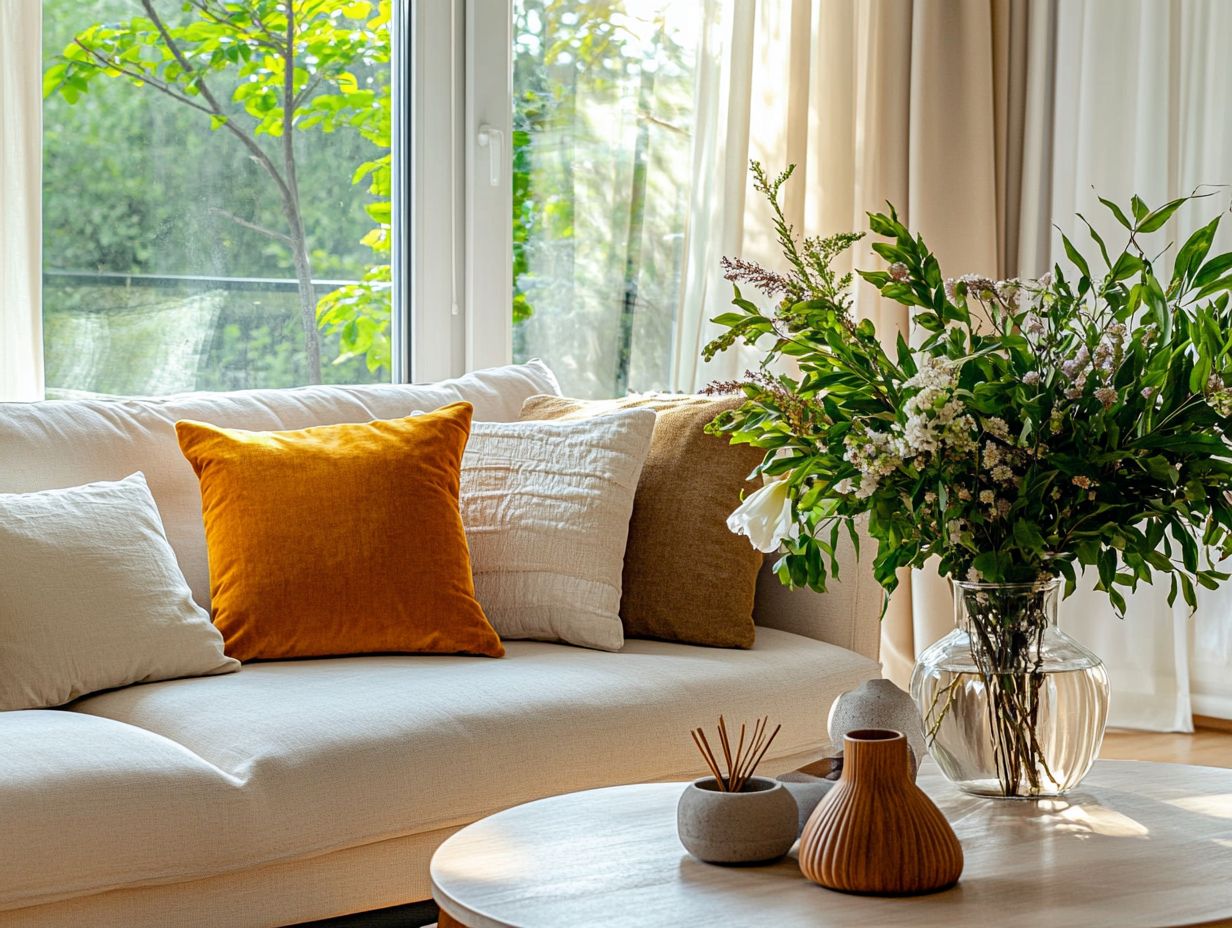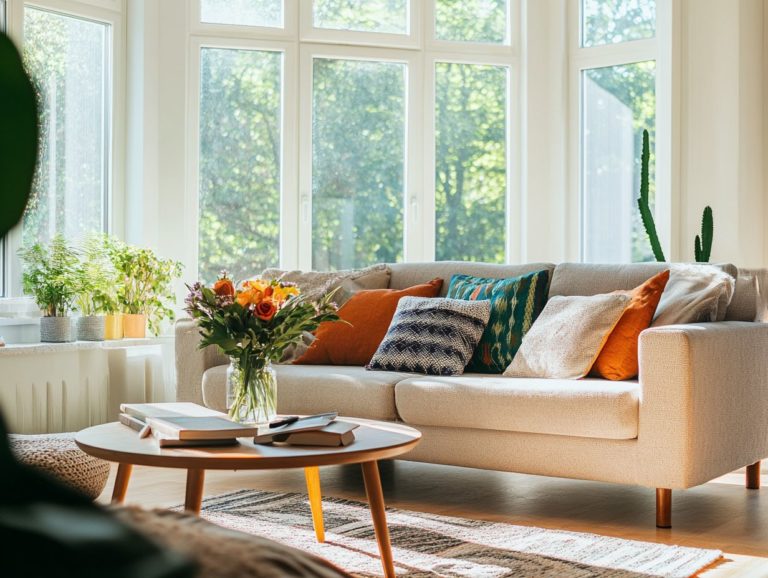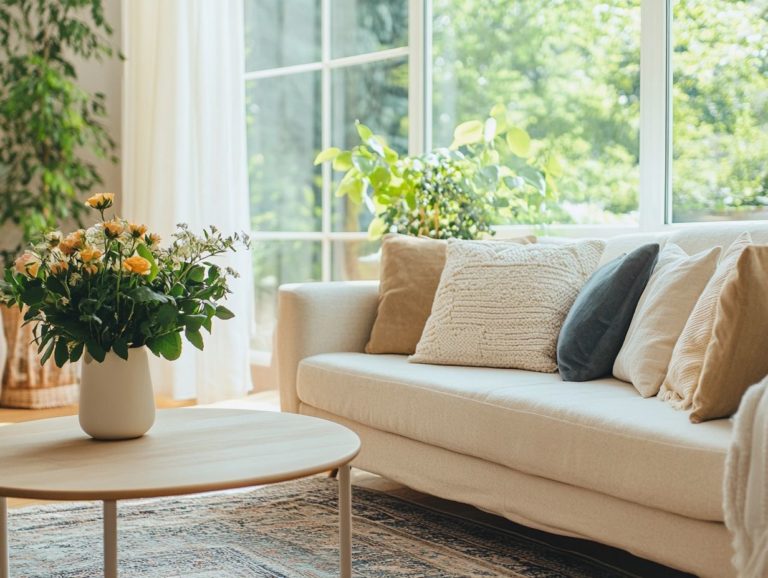How to Stage a Home for Quick Impressions
Home staging goes beyond simply arranging furniture; it makes a home more attractive to buyers.
This exploration looks at the essence of home staging and how it impacts buyer perception. Ultimately, this process can elevate your sale price and speed up the selling process.
You’ll discover helpful tips on preparing your home, decluttering effectively, using strategic staging techniques, and enhancing curb appeal.
Working with a professional stager can significantly improve your home’s appeal. Learn how to make your home stand out and attract eager buyers!
Contents
- Key Takeaways:
- Understanding Home Staging
- Benefits of Staging a Home
- Preparing Your Home for Staging
- Staging Tips and Techniques
- Maximizing Curb Appeal
- Working with a Professional Stager
- Frequently Asked Questions
- What is the purpose of staging a home for quick impressions?
- What are some basic tips for staging a home for quick impressions?
- How can I use lighting to enhance the quick impression of a staged home?
- Do I need to hire a professional stager to stage my home for quick impressions?
- What are some common mistakes to avoid when staging a home for quick impressions?
- How can I make a small space feel larger when staging for quick impressions?
Key Takeaways:

Understand the concept of home staging and its purpose in selling a property.
Utilize staging techniques such as decluttering, highlighting key features, and maximizing curb appeal to influence buyer perception and increase the sale price and speed of your home. For more detailed strategies, check out this guide on how to stage a home in a competitive market.
Consider hiring a professional stager for their expertise and potential to maximize the success of your home staging efforts.
Understanding Home Staging
Home staging is a vital strategy in the real estate market that makes a home more attractive to potential buyers. It often transforms ordinary spaces into inviting, show-ready homes.
This process requires careful planning and execution. The goal is to create an emotional connection through effective visual merchandising, which means arranging items in an appealing way to attract buyers.
By using neutral colors, fresh flowers, and minor repairs, home staging can enhance spaces like the living room and kitchen. Understanding the do’s and don’ts of home staging significantly influences how buyers perceive the property.
A professionally staged home creates a favorable first impression that resonates with buyers, making it an essential step in your home selling journey. For more insights, consider exploring selling your home fast: staging tips.
What is Home Staging?
Home staging is the art of preparing your residential property for sale in a competitive market by enhancing its aesthetic appeal. This process involves strategically arranging furniture to optimize space and flow, creating a welcoming and cozy environment.
For example, you might use decorative pillows to add color and style while making seating areas more inviting. A thoughtful selection of vibrant flowers can bring life into your home, appealing directly to the emotions of prospective buyers.
Successful staging often highlights neutral palettes complemented by eye-catching accents, allowing each room to feel both airy and warm.
Imagine how a beautifully staged living room can evoke feelings of comfort and tranquility, making it memorable and truly desirable for anyone touring the property.
Benefits of Staging a Home
Staging a home offers many advantages that can significantly influence both the selling price and the overall appeal of a property in today’s competitive real estate landscape, including staging secrets to attract buyers.
By creating an inviting atmosphere, you align the space with buyer expectations, making it more attractive and enticing to potential buyers.
Influencing Buyer Perception
The way you stage your home can greatly influence buyer perception, creating an emotional connection that encourages potential buyers to imagine themselves in the space. Learning how to successfully stage your home is crucial, as it can sway decisions and lead to quicker sales.
Industry professionals emphasize the importance of strategic staging techniques. For instance, using high-gloss paint can enhance light and make rooms feel larger. Additionally, staging your home: tips for small spaces suggests that minimalist kitchen designs can reduce distractions, allowing buyers to focus on the home’s potential rather than clutter.
These thoughtful choices not only highlight the property’s best features but also engage buyer psychology. This enables prospective homeowners to project their lifestyle and aspirations onto the staging. Ultimately, this approach increases the appeal of the home and enhances its marketability.
Start staging your home today to attract buyers quickly and sell at the best price!
Increasing Sale Price and Speed

Proper home staging elevates aesthetic appeal and plays a pivotal role in enhancing the sale price and speeding up the sale process in today s competitive real estate market.
Studies show that staged homes sell up to 73% faster than those that aren t staged. For instance, professionally staged homes typically fetch an average of 10% more than their unfurnished counterparts.
These statistics underscore the compelling advantages of staging. This motivates sellers like you to invest in expert techniques that showcase your property s finest features.
Simple actions, such as decluttering, opting for neutral paint colors, and strategically arranging furniture, can greatly enhance your home’s appeal. For more detailed strategies, consider staging for open houses: best practices to create an inviting atmosphere that resonates with potential buyers.
By presenting spaces that feel open and functional, you can make the buyer s decision-making process smoother, leading to quicker offers and higher sale prices.
Preparing Your Home for Staging
Preparing your home for staging is a meticulous process requiring several thoughtful steps.
- Begin by decluttering your space to create an inviting atmosphere.
- Next, attend to any minor repairs that may detract from your home s appeal.
- Finally, organize each area to reflect contemporary interior design trends, resulting in a home that’s ready to impress buyers.
Decluttering and Depersonalizing
Decluttering and depersonalizing your home is a crucial first step in the staging process. This allows potential buyers to envision their lives within the space.
To achieve this, begin by removing personal photographs and mementos that may distract visitors from your home s standout features. Minimize excessive decor so that key architectural elements can shine.
Organize your belongings into three categories: keep, donate, and discard. This approach encourages effective decluttering and fosters a streamlined, inviting atmosphere.
Investing in suitable storage solutions can help you maintain a tidy presentation that impresses potential buyers.
Minor Repairs and Updates
Making minor repairs and updates is essential to the home staging process. Every detail contributes to a clean and appealing look that captivates potential buyers.
Addressing common issues like fixing leaky faucets or patching drywall significantly enhances your space’s overall presentation. Potential buyers often notice these small defects, which can create an impression of neglect.
Incorporating fresh scents, like natural oils or light candles, creates an inviting atmosphere that elevates your home’s appeal. Pair these repairs with low-cost updates, like a fresh coat of paint or new hardware for cabinets, to enhance your home s look and feel, making it truly memorable for visitors.
Every small change can influence a buyer’s decision.
Staging Tips and Techniques
By implementing effective staging tips and techniques, you can craft an inviting atmosphere that captivates potential buyers and significantly enhances your property’s marketability.
Creating a Welcoming Atmosphere

Creating a welcoming atmosphere is essential in home staging. It involves a thoughtful blend of lighting and decor, alongside inviting elements like cozy seating and fresh flowers that make potential buyers feel right at home.
Select soft, warm lighting fixtures think elegant table lamps and stylish pendant lights to enhance the comfort and intimacy of each room.
Imagine a well-placed array of cushions on a welcoming sofa that beckons visitors, while an artfully arranged coffee table featuring beautiful floral arrangements adds a touch of sophistication.
Successful home staging showcases spaces that harness natural light to their advantage, complemented by layered lighting sources that create depth and warmth. This meticulous staging accentuates your property s finest features and encourages potential buyers to imagine living comfortably within those inviting walls.
Start staging your home today and watch the offers roll in!
Highlighting Key Features
Highlighting the key features of your home during the staging process can craft an enticing layout that captures potential buyers’ attention. This showcases the property s most attractive elements.
Enhance the charm of your outdoor spaces. Showcase the elegance of your kitchen design. Focus on amplifying the allure of hardwood floors.
Frame those outdoor areas with inviting seating arrangements or vibrant potted plants. This creates a welcoming atmosphere. Meanwhile, accentuate your hardwood floors with strategically placed area rugs to add warmth and character, drawing the eye to the stunning grain.
In the kitchen, complement modern appliances with tasteful accessories like decorative bowls or stylish cutting boards. This highlights functionality while exuding an inviting ambiance.
These thoughtful choices create a harmonious experience that resonates with buyers. They ll envision their future in the space.
Maximizing Curb Appeal
Maximizing curb appeal is essential for crafting a favorable first impression. It sets the stage for potential buyers long before they cross the threshold of your home.
Careful landscaping and well-designed outdoor living spaces can elevate the allure of your property.
First Impressions Matter
First impressions hold tremendous weight in real estate. Focusing on curb appeal during home staging is crucial to attract potential buyers and ignite their interest from the moment they arrive. For more detailed strategies, consider exploring how to stage a home for a family.
The visual allure of a property from the street significantly influences a buyer’s perception and emotional response. This often shapes their eagerness to explore further. As prospective buyers approach your home, their initial observations can lead to assumptions about the overall quality and upkeep of the property.
To elevate your curb appeal, consider simple yet impactful upgrades, such as:
- Maintaining the lawn
- Updating outdoor lighting
- Ensuring the front entrance is inviting
Incorporating fresh flowers, repainting the front door, and cleaning walkways can also create a warm and welcoming atmosphere. This leaves a lasting impression that reinforces positive feelings about your home.
Working with a Professional Stager
Collaborating with a professional stager can transform the staging process. Their expert knowledge and refined techniques captivate potential buyers and elevate your property s overall market value.
Benefits and Considerations

Engaging a professional stager offers numerous benefits that enhance your home investment in the real estate market. It s essential to consider these advantages alongside potential considerations.
You may notice an increase in your sale price. Studies have shown that homes staged professionally can sell for up to 10% more than their unstaged counterparts. Properties tend to fly off the market, attracting prospective buyers almost immediately.
Factor in the costs involved in hiring a stager, which can vary depending on the project’s scope and the stager s expertise. Aligning the staging process with your personal style ensures your home remains authentic and inviting while still appealing to a broader audience.
Even modest investments in staging can yield impressive returns, reinforcing the case for seeking professional assistance.
Frequently Asked Questions
What is the purpose of staging a home for quick impressions?
Staging creates a strong first impression, making buyers eager to explore more.
What are some basic tips for staging a home for quick impressions?
Basic tips include decluttering and depersonalizing the space, maximizing natural light, and creating a neutral and inviting atmosphere.
How can I use lighting to enhance the quick impression of a staged home?
Lighting is crucial in creating a good first impression. Open curtains and blinds to maximize natural light. Strategically place lamps or overhead lights to create a warm and welcoming ambiance.
Do I need to hire a professional stager to stage my home for quick impressions?
Hiring a professional stager isn t a must, but it can be very helpful. Their expertise can create a space that looks good and invites potential buyers in.
What are some common mistakes to avoid when staging a home for quick impressions?
Avoid over-decorating and remember to think about your target market. Don’t forget to update any outdated features that might turn buyers away.
How can I make a small space feel larger when staging for quick impressions?
Choose light, neutral colors to brighten up your space! Remove unnecessary furniture and use mirrors to reflect light, creating the illusion of more space.






